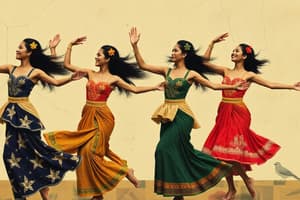Podcast
Questions and Answers
What is the Pasiyam celebration in Philippine culture?
What is the Pasiyam celebration in Philippine culture?
- A ritual for purification
- A gathering to honor the living
- A festival for crop harvesting
- A celebration held on the ninth night after a person's death (correct)
Which term refers to the cloth wrapped around the waist for women?
Which term refers to the cloth wrapped around the waist for women?
- Bahag
- Diwata
- Panghugas
- Tapis (correct)
What does the Kaingin system refer to in agriculture?
What does the Kaingin system refer to in agriculture?
- A type of irrigation system
- A technique involving the burning of land for farming (correct)
- An organic farming technique
- A method of crop rotation
Which of the following correctly describes the Barter System?
Which of the following correctly describes the Barter System?
Who are considered Maharlika in the social hierarchy?
Who are considered Maharlika in the social hierarchy?
What does the term Agimat/Anting-Anting refer to?
What does the term Agimat/Anting-Anting refer to?
What is the common characteristic of Filipino time?
What is the common characteristic of Filipino time?
What role do Diwata play in Filipino culture?
What role do Diwata play in Filipino culture?
Flashcards are hidden until you start studying
Study Notes
Cultural Practices in Philippine History
- Pasiyam: A commemoration held nine nights post-death, notable for being established by Datu Kalantiaw, the third chief of Panay.
- Code of Kalantiaw: Reflects Chinese influences on Filipino societal structures and customs.
- Economic Influences: Primarily impacted by Indian culture, shaping trade and social relations in early Filipino communities.
Traditional Clothing
- Bahag: A traditional garment wrapped around the waist; men's attire often leaves thighs and legs exposed.
- Tapis: A cloth worn by women, symbolizing modesty and traditional femininity.
- Ancient House: Constructed from wood, bamboo, and nipa-palm leaves, showcasing early Filipino architectural practices.
Social Stratification
- Maharlika/Freeman: Individuals with noble standing; often served the chief and held significant social status.
- Alipin/Dependents: Status acquired through heritage, war captivity, debt, or crime, representing a complex social hierarchy.
- Nobles: Chiefs and their families who wielded considerable influence and power within their communities.
Spiritual Beliefs and Practices
- Anitos/Saints: Spirits or deities worshipped by Filipinos; offerings are made for protection and guidance.
- Diwata: A term used in the Visayas referring to deities similar to Anitos, embodying spiritual connections.
- Bathalang Maykapal: The supreme creator deity, akin to the Spanish concept of Dios.
Folklore and Mythology
- Tiyanak: A mythical creature that preys on unborn babies, reflecting fears and beliefs regarding life and death.
- Tikbalang: A trickster creature known for misleading travelers by shapeshifting or altering paths.
- Mangkukulam: A practitioner of witchcraft who uses doll representations to inflict harm on others.
Economic Systems
- Kaingin System: A slash-and-burn method of agriculture emphasizing the relationship between farmers and the land.
- Barter System: A direct goods exchange method, avoiding monetary transactions in favor of a more communal economic practice.
Social Attributes of Filipinos
- Filipino Time: Cultural tendency towards lateness, often extending from minutes to several hours compared to punctual standards.
- Disregarding Rules: A prevalent behavior where personal interests take precedence over established regulations.
- Helpfulness: A collective trait highlighting the community-focused nature of Filipino society.
- Resilience and Adaptability: An ability to cope with challenges and recover from difficulties, showcasing the strength of Filipino character.
Core Values
- Jolliness and Sense of Humor: A defining characteristic of Filipino culture, known for its positivity and light-heartedness.
- Bravery: Reflects mental and moral strength in facing adversities.
- Resourcefulness and Creativity: Emphasizes innovative approaches to problem-solving and creating unique solutions.
- Faithfulness and Hope: Deep-rooted belief in maintaining faith regardless of circumstances, looking forward to a better future.
- Politeness and Respect: The importance placed on courteous behavior towards others.
- Gratefulness and Thriftiness: Cultivating appreciation for kindness, alongside the careful management of resources and financial prudence.
- Honesty and Commitment: Fundamental traits celebrated within Filipino culture, reflecting integrity and dedication in personal and communal life.
Studying That Suits You
Use AI to generate personalized quizzes and flashcards to suit your learning preferences.




